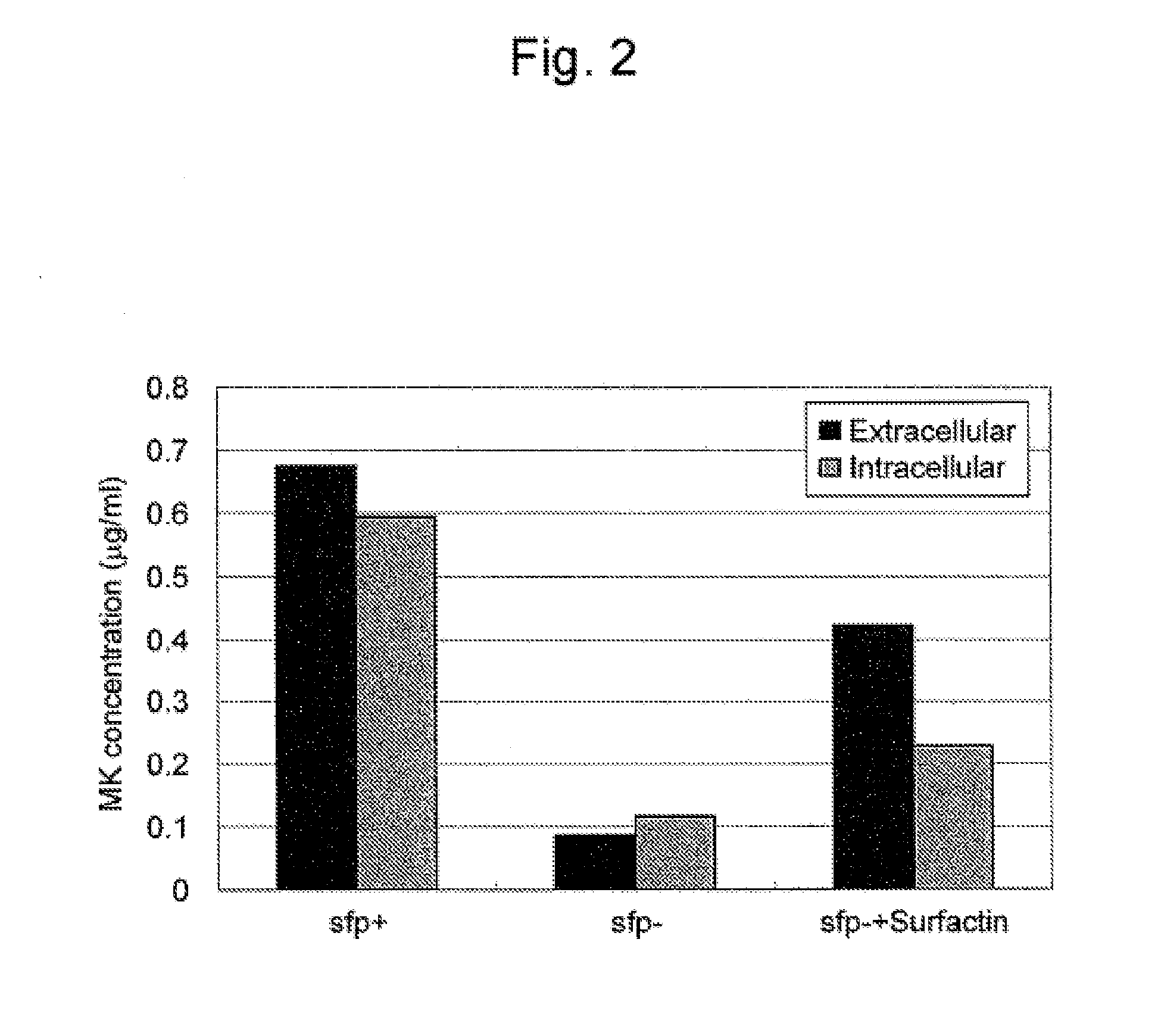Method for producing quinones
- Summary
- Abstract
- Description
- Claims
- Application Information
AI Technical Summary
Benefits of technology
Problems solved by technology
Method used
Image
Examples
example 1
Differences in Menaquinone Yield Resulting from the Presence or the Absence of Porous Carriers
[0053]One polytetrafluoroethylene porous tube (Poreflon tube TB-0403; Sumitomo Electric Fine Polymer Inc.) cut to a length of 13 cm was placed in a 50-mL conical tube (Bioscience) as a porous carrier. Thirty mL of LB medium with the following composition was added, and then 300 μL of a solution (OD600=0.3) prepared by diluting Bacillus subtilis with sterile water was introduced into the tube. After introduction, static culture was carried out for 24 hours at 37° C. As a control, culture was separately carried out using a culture solution alone into which no porous carrier had been added. After completion of culture, the amount of menaquinone (MK) in each culture solution was measured. FIG. 1 shows the results.
Medium composition (LB medium): Bacto Tryptone 10.0 g / L, yeast extract 5.0 g / L, sodium chloride 5.0 g / L, pH=7.3
[0054]As is understood from the results in FIG. 1, culture in the presenc...
example 2
Differences in Yield Resulting from Biosurfactants
[0055]With the use of an experimental Bacillus subtilis strain 168 (ATCC 6051) (sfp− strain) producing no surfactin which is the biosurfactant and an sfp+strain prepared by introducing a surfactin synthesis gene (sfp) into the sfp− strain, the amounts of menaquinone produced were compared. The sfp+ strain was prepared introducing a plasmid vector in which the sfp gene had been incorporated into an sfp− strain. Culture was carried out in a manner similar to that in Example 1. The sfp+strain alone, the sfp− strain alone and a culture solution of the sfp− strain to which surfactin had been added were used.
[0056]100 mL of LB medium prepared in a manner similar to that in Example 1 was added to a 500-mL conical tube (Bioscience) and then 1 mL of the sfp+strain and 1 mL of the sfp− strain were each introduced. Also, separately, 1 mL of the sfp− strain was introduced and then surfactin was dissolved to a final concentration of 116 μM (the s...
example 3
Differences in Menaquinone Yield Resulting from Biofilms
[0058]The sfp+ strain and the sfp− strain prepared in Example 2 were subjected to static culture under conditions similar to those in Example 1 in the presence of a porous carrier for 24 hours. The amounts of menaquinone produced were compared. At 4, 8, 12, 16, 20 and 24 hours after initiation of culture, the amount of menaquinone in each culture solution and the amount of biofilm formed were measured. The results are shown in FIG. 3.
[0059]As is understood from the results in FIG. 3, menaquinone yield was significantly higher in the sfp+ strain producing surfactin than in the sfp− strain producing no surfactin. Also, a biofilm was formed in a greater amount in the sfp+ strain producing surfactin than the sfp− strain producing no surfactin.
PUM
 Login to View More
Login to View More Abstract
Description
Claims
Application Information
 Login to View More
Login to View More - R&D
- Intellectual Property
- Life Sciences
- Materials
- Tech Scout
- Unparalleled Data Quality
- Higher Quality Content
- 60% Fewer Hallucinations
Browse by: Latest US Patents, China's latest patents, Technical Efficacy Thesaurus, Application Domain, Technology Topic, Popular Technical Reports.
© 2025 PatSnap. All rights reserved.Legal|Privacy policy|Modern Slavery Act Transparency Statement|Sitemap|About US| Contact US: help@patsnap.com



